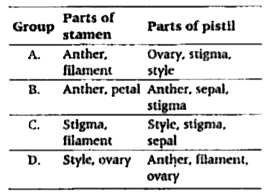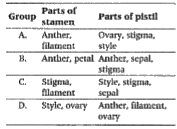What part is played by stamens and carpels in reproduction?
Step-by-Step Solution:
1. Understanding Reproduction:
- Reproduction is the biological process through which organisms produce offspring. There are two main types of reproduction: asexual and sexual.
2. Types of Reproduction:
- Asexual Reproduction: This type does not involve the formation of gametes (reproductive cells).
- Sexual Reproduction: This involves the formation of gametes, which are essential for the fusion process known as fertilization.
3. Role of Stamens and Carpels:
- In plants that reproduce sexually, there are specialized structures called stamens and carpels.
- Stamens: These are the male reproductive organs of a flower. They produce pollen, which contains male gametes.
- Carpels (or Pistils): These are the female reproductive organs of a flower. They produce eggs, which are the female gametes.
4. Fertilization Process:
- During reproduction, the male gametes (pollen) from the stamens fuse with the female gametes (eggs) from the carpels. This fusion is known as fertilization.
- After fertilization, a zygote is formed, which eventually develops into a seed.
5. Conclusion:
- The primary role of stamens and carpels in reproduction is the formation of gametes. Stamens produce male gametes (pollen), while carpels produce female gametes (eggs). This gamete formation is crucial for the process of sexual reproduction in plants.
- Reproduction is the biological process through which organisms produce offspring. There are two main types of reproduction: asexual and sexual.
- Asexual Reproduction: This type does not involve the formation of gametes (reproductive cells).
- Sexual Reproduction: This involves the formation of gametes, which are essential for the fusion process known as fertilization.
- In plants that reproduce sexually, there are specialized structures called stamens and carpels.
- Stamens: These are the male reproductive organs of a flower. They produce pollen, which contains male gametes.
- Carpels (or Pistils): These are the female reproductive organs of a flower. They produce eggs, which are the female gametes.
- During reproduction, the male gametes (pollen) from the stamens fuse with the female gametes (eggs) from the carpels. This fusion is known as fertilization.
- After fertilization, a zygote is formed, which eventually develops into a seed.
- The primary role of stamens and carpels in reproduction is the formation of gametes. Stamens produce male gametes (pollen), while carpels produce female gametes (eggs). This gamete formation is crucial for the process of sexual reproduction in plants.
Topper's Solved these Questions
- STRUCTURE AND FUNCTIONS OF PLANT PARTSBOOK - BETOPPERSCHAPTER - STRUCTURE AND FUNCTIONS OF PLANT PARTSEXERCISE - SUMMATIVE WORKSHEET (ODD ONE OUT)
5 Videos
- STRUCTURE AND FUNCTIONS OF PLANT PARTSBOOK - BETOPPERSCHAPTER - STRUCTURE AND FUNCTIONS OF PLANT PARTSEXERCISE - SUMMATIVE WORKSHEET (TRUE OR FALSE)
14 Videos
- SOILBOOK - BETOPPERSCHAPTER - SOILEXERCISE - SUMMATIVE WORKSHEET
14 Videos
Similar Questions
Knowledge Check
When both essential floral organs (stamens and carpels ) are present in a flower the flower is called
AbisexualBneuterCandromonoeciousDheteromerousPresence of mechanical barrier between stamen and carpel which prevents self pollination , is known as :
AProtonadryBProtogynyCHomogamyDHerkogamyAssertion. In family Liliaceae, perianth, stamens and carpels are present. But still it is incomplete.
Reason. In complete flower calyx, corolla, androecium and gynoecium are present.AIf both Assertion and Reason are true and the Reason is a correct explanation of the Assertion.BIf both Assertion and Reason are true but Reason is not a correct explanation of the Assertion.CIf Assertion is true but the Reason is false.DIf both Assertion and Reason are false.
What role does electrostatics play in the reproduction of floweres ?
View SolutionStructure of flower |Stamens |Carpel ( pistil )|Types of flowers |Steps involved in reproduction |Pollination
View SolutionStudy the following table.

The group in which the parts of stamen and parts of pistil are correctly shown is
View SolutionStudy the following table.

The group in which the parts of stamen and parts of pistil are correctly shown is
View SolutionRose has several whorls of petals, stamens and carpels. Its flower is
View Solution
